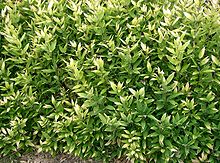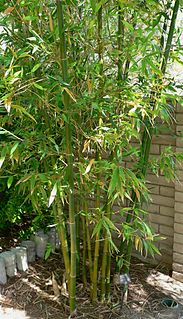
Bambusa is a large genus of clumping bamboos. Most species of Bambusa are rather large, with numerous branches emerging from the nodes, and one or two much larger than the rest. The branches can be as long as 11 m (35 ft).
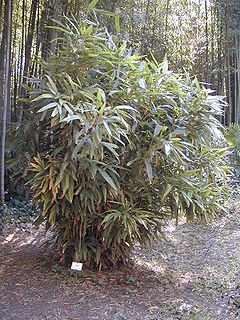
Indocalamus is a genus of about 35 species of flowering plants in the grass family Poaceae, native to China, Vietnam and Japan. They are quite small evergreen bamboos normally up to 2 m (6.6 ft) in height, initially forming clumps and then spreading to form larger thickets. They have thick, glossy leaves. Ruo leaves use to wrap foods like rice during dragon boat festival, originate in fujian refer to Indocalamus longiauritusoriginally but now are nonspecific to just about any leaf wrap.

Semiarundinaria is a genus of East Asian bamboo in the grass family.

Sinobambusa is a genus of East Asian bamboo in the grass family. It is native to China and Vietnam. Sinobambusa tootsik also occurs in Japan, having been introduced there during the Tang Dynasty (618–907).
- Sinobambusa baccanensisT.Q.Nguyen – Vietnam
- Sinobambusa farinosa(McClure) T.H.Wen – Fujian, Guangdong, Guangxi, Jiangxi, Zhejiang
- Sinobambusa henryi(McClure) C.D.Chu & C.S.Chao – Guangdong, Guangxi
- Sinobambusa humilaMcClure – Guangdong
- Sinobambusa incanaT.H.Wen – Guangdong
- Sinobambusa intermediaMcClure – Fujian, Guangdong, Guangxi, Sichuan, Yunnan
- Sinobambusa nephroauritaC.D.Chu & C.S.Chao – Guangdong, Guangxi, Sichuan
- Sinobambusa rubroligulaMcClure – Guangdong, Guangxi, Hainan
- Sinobambusa sat(Balansa) C.S.Chao & Renvoize – Vietnam
- Sinobambusa scabridaT.H.Wen – Guangxi
- Sinobambusa solearis(McClure) T.Q.Nguyen – Vietnam
- Sinobambusa tootsik(Makino) Makino ex Nakai – Fujian, Guangdong, Guangxi, Vietnam; naturalized in Japan including Ryukyu Islands
- Sinobambusa yixingensisC.S.Chao & K.S.Xiao – Jiangsu

Adenophora is a genus of flowering plants in the family Campanulaceae, the bellflowers. Plants of this genus are known commonly as ladybells. Most are native to eastern Asia, with a few in Europe. Many are endemic to either China or Siberia.

Osmanthus is a genus of about 30 species of flowering plants in the family Oleaceae. Most of the species are native to eastern Asia with a few species from the Caucasus, New Caledonia and Sumatra.

Acidosasa is a genus of East Asian bamboo in the grass family.
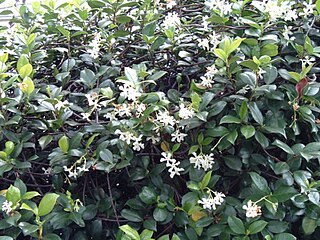
TrachelospermumStar Jasmine, Confederate Jasmine, is a genus of evergreen woody vines in the dogbane family Apocynaceae, first described as a genus in 1851. All species are native to southern and eastern Asia.

Croomia is a genus of primitive angiosperm herbs in the Stemonaceae family, first described as a genus in 1840.
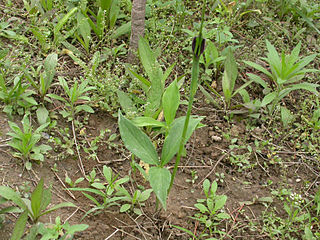
Pinellia is a genus of plants in the family Araceae native to East Asia. Its species are commonly called green dragons due to the color and shape of the inflorescence, which possesses a green, hooded spathe from which protrudes a long, tongue-like extension of the spadix. The leaves vary greatly in shape among different species, from simple and cordate to compound with three to many leaflets. Pinellia reproduces rapidly from seed and many species also produce bulbils on the leaves. Both characteristics have allowed some species to become weedy in temperate areas outside their native range, notably Pinellia ternata in eastern North America.

Lycoris is a genus of 13–20 species of flowering plants in the family Amaryllidaceae, subfamily Amaryllidoideae. They are native to eastern and southern Asia in China, Japan, southern Korea, northern Vietnam, northern Laos, northern Thailand, northern Burma, Nepal, northern Pakistan, Afghanistan, and eastern Iran. They were imported into North Carolina and now grow wild. In English they are also called hurricane lilies or cluster amaryllis. The genus shares the English name spider lily with two other related genera.

Neyraudia is a genus of Asian and African plants in the grass family.

Synurus is a genus of Asian plants in the thistle tribe within the daisy family.
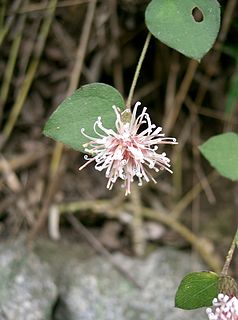
Pertya is a genus of Asian flowering plants in the daisy family (Asteraceae).

Shibataea kumasaca (倭竹), the ruscus-leaf bamboo or ruscus bamboo, is a species of flowering plant in the grass family, native to mountain slopes in Fujian and Zhejiang provinces in China, and widely cultivated elsewhere. Growing to 1.5 m (4.9 ft) tall, it is a compact, clump-forming evergreen bamboo.

Callicarpa (beautyberry) is a genus of shrubs and small trees in the family Lamiaceae. They are native to east and southeast Asia, Australia, Madagascar, southeast North America and South America.
Matsumurella is a genus of flowering plants in the family Lamiaceae, first described in 1915. It is native to China and Japan. The genus is closely related to Galeobdolon, and the species below are discussed under that name in Flora of China.
- Matsumurella chinensis(Benth.) Bendiksby - Anhui, Fujian, Guangdong, Guangxi, Hunan, Jiangsu, Jiangxi, Taiwan, Zhejiang
- Matsumurella kwangtungensis(C.Y.Wu) Bendiksby - Guangdong
- Matsumurella szechuanensis(C.Y.Wu) Bendiksby - Chongqing
- Matsumurella tuberifera(Makino) Makino - Japan, Ryukyu Islands, Taiwan, Guangxi, Hunan, Jiangxi
- Matsumurella yangsoensis(Y.Z.Sun) Bendiksby - Guangxi

Meehania is a genus of flowering plants in the family Lamiaceae, first described in 1894. It is native to China, Japan, and the eastern United States.
- Meehania cordata(Nutt.) Britton - Appalachian Mountains of eastern United States
- Meehania faberi(Hemsl.) C.Y.Wu - Gansu, Sichuan
- Meehania fargesii(H.Lév.) C.Y.Wu - Guangdong, Guangxi, Guizhou, Hubei, Hunan, Jiangxi, Sichuan, Yunnan, Zhejiang
- Meehania henryi(Hemsl.) Y.Z.Sun ex C.Y.Wu - Guizhou, Hubei, Hunan, Sichuan
- Meehania montis-koyaeOhwi - Honshu, Fujian, Zhejiang
- Meehania pinfaensis(H.Lév.) Y.Z.Sun ex C.Y.Wu - Guizhou
- Meehania urticifolia(Miq.) Makino - Japan, Korea, Russian Far East, Jilin, Liaoning

Mosla is a genus of plants in the family Lamiaceae, first described as a genus in 1875. It is native to eastern Asia, the Himalayas, and southeastern Asia.
- Mosla bracteataDoan ex Suddee & A.J.Paton - Vietnam
- Mosla cavalerieiH.Lév.- Vietnam, Guangdong, Guangxi, Guizhou, Hubei, Jiangxi, Sichuan, Yunnan, Zhejiang
- Mosla chinensisMaxim. - Vietnam, Korea, Japan, Anhui, Fujian, Guangdong, Guangxi, Guizhou, Hubei, Hunan, Jiangsu, Jiangxi, Shandong, Sichuan, Taiwan, Zhejiang
- Mosla coreanaH.Lév. - Korea
- Mosla dianthera(Buch.-Ham. ex Roxb.) Maxim. - China, Japan, Korea, Ryukyu Islands, Kuril Islands, Primorye, Caucasus, Himalayas, Myanmar, Vietnam, Philippines, Sumatra
- Mosla exfoliata(C.Y.Wu) C.Y.Wu & H.W.Li - Sichuan
- Mosla hangchouensisMatsuda - Zhejiang
- Mosla japonica(Benth. ex Oliv.) Maxim. - Japan, Korea, Ryukyu Islands
- Mosla longibracteata(C.Y.Wu & S.J.Hsuan) C.Y.Wu & H.W.Li - Guangxi, Zhejiang
- Mosla longispica(C.Y.Wu) C.Y.Wu & H.W.Li - Jiangxi
- Mosla pauciflora(C.Y.Wu) C.Y.Wu & H.W.Li - Guizhou, Hubei, Sichuan
- Mosla punctulataNakai - Korea, Taiwan, Japan, China
- Mosla scabra(Thunb.) C.Y.Wu & H.W.Li - Vietnam, Korea, Japan, Ryukyu Islands, Anhui, Fujian, Gansu, Guangdong, Guangxi, Henan, Hubei, Hunan, Jiangsu, Jiangxi, Liaoning, Shaanxi, Sichuan, Taiwan, Zhejiang
- Mosla soochouensisMatsuda - Anhui, Jiangsu, Jiangxi, Zhejiang
- Mosla tamdaoensisPhuong - Vietnam
Sasamorpha is a genus of East Asian bamboo in the grass family.
- Sasamorpha borealis(Hack.) Nakai – Korea, Japan, Sakhalin
- Sasamorpha hubeiensisC.H.Hu – Hubei, Jiangxi
- Sasamorpha oshidensis(Makino & Uchida) Nakai – Japan
- Sasamorpha qingyuanensisC.H.Hu – Zhejiang
- Sasamorpha sinica(Keng) Koidz. – Anhui, Zhejiang
